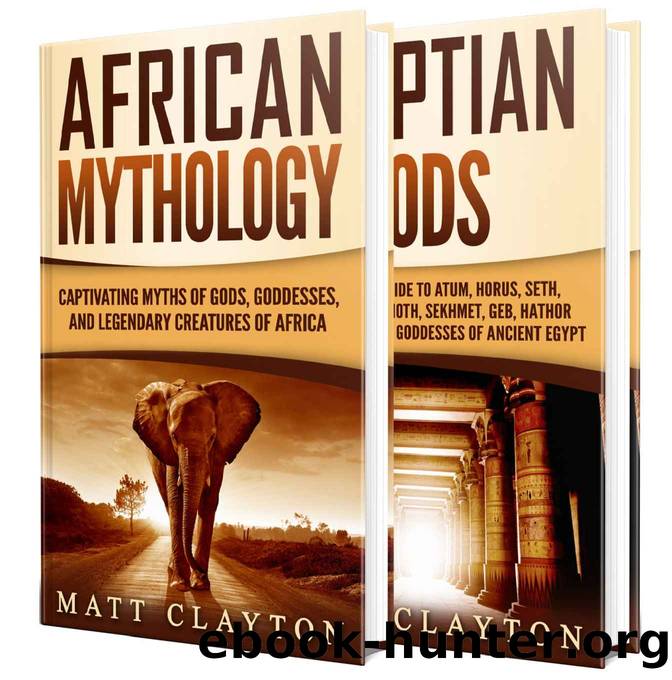African Myths and Egyptian Gods: A Captivating Guide to African Mythology and Gods of Ancient Egypt by Matt Clayton

Author:Matt Clayton [Clayton, Matt]
Language: eng
Format: azw3
Published: 2020-08-24T00:00:00+00:00
Anubis (Anpu, Inpw)
With his black jackalâs head perched upon a manâs body, Anubis is one of the most easily identified ancient Egyptian deities. Some depictions of this god show him holding the ankh, or symbol of life, in one hand and a staff in the other, while other images show him tending to the dead body of a pharaoh. This association with death and decay is one of Anubisâs chief characteristics. Indeed, his name in Egyptian, Anpu, literally means âdecayâ (âAnubisâ is the Greek form of the name), and it is possible that the use of the jackalâs head as one of the attributes of this god may be a reference to the tendency of jackals to scavenge in cemeteries and other places where dead bodies are found.
Although Anubis was always considered to be a god of death and the dead, his position within Egyptian religion altered over time. During the First Dynasty, Anubis was the primary god of the dead, but this changed during the Middle Kingdom, when the cult of Osiris gained popularity and Osiris was elevated to the supreme god of the dead and lord of the Tuat, the ancient Egyptian Underworld. Anubis may have lost his throne to Osiris, but he did not lose his importance; instead, his role shifted from ruler of the dead to embalmer and judge.
The myths surrounding Anubisâs origins and parentage also changed over time. In some early myths, Anubis is said to be the son of the sun god Ra and the brother of Osiris, Isis, Nephthys, and Set, either by the sky goddess Nut or the cow-headed goddess Hesat. In later myths, he is considered to be the son of Nephthys, who tricked Osiris into having intercourse with her. This shift likely had to do with the increasing importance of the Osiris cult and the need to incorporate Anubis into a new mythical and religious framework that centered on Osiris, rather than Anubis, as the god of the dead.
One of Anubisâs chief duties in the Tuat was the judging of souls to see whether or not they were worthy of eternal life. When the soul of a deceased person came before Anubis, Anubis weighed their heart against the feather of truth. The deceased person then had to vow that they had lived a good life full of good deeds. If the person was telling the truth, the heart would weigh less than the feather, and the person would be allowed into the delights of the afterlife. If the person was lying, however, the heart would weigh more than the feather, and the person would be condemned to obliteration by being devoured by Ammit, a goddess with the head of a crocodile, the forequarters of a lion, and the hindquarters of a hippopotamus.
Anubis was also the god of embalming, a role that became important after the rise of the Osiris cult. When Isis finds Osirisâs dead body, Anubis helps her embalm it and wrap it in linen wrappings. The other part
Download
This site does not store any files on its server. We only index and link to content provided by other sites. Please contact the content providers to delete copyright contents if any and email us, we'll remove relevant links or contents immediately.
| Africa | Americas |
| Arctic & Antarctica | Asia |
| Australia & Oceania | Europe |
| Middle East | Russia |
| United States | World |
| Ancient Civilizations | Military |
| Historical Study & Educational Resources |
The Daily Stoic by Holiday Ryan & Hanselman Stephen(2703)
The Fate of Rome: Climate, Disease, and the End of an Empire (The Princeton History of the Ancient World) by Kyle Harper(2429)
People of the Earth: An Introduction to World Prehistory by Dr. Brian Fagan & Nadia Durrani(2345)
Ancient Worlds by Michael Scott(2098)
Babylon's Ark by Lawrence Anthony(2066)
Foreign Devils on the Silk Road: The Search for the Lost Treasures of Central Asia by Peter Hopkirk(2052)
India's Ancient Past by R.S. Sharma(1982)
MOSES THE EGYPTIAN by Jan Assmann(1968)
The Complete Dead Sea Scrolls in English (7th Edition) (Penguin Classics) by Geza Vermes(1835)
Lost Technologies of Ancient Egypt by Christopher Dunn(1796)
The Daily Stoic by Ryan Holiday & Stephen Hanselman(1764)
The Earth Chronicles Handbook by Zecharia Sitchin(1742)
24 Hours in Ancient Rome by Philip Matyszak(1675)
Alexander the Great by Philip Freeman(1642)
Aztec by Gary Jennings(1539)
The Nine Waves of Creation by Carl Johan Calleman(1518)
Curse Tablets and Binding Spells from the Ancient World by Gager John G.;(1509)
Before Atlantis by Frank Joseph(1481)
Earthmare: The Lost Book of Wars by Cergat(1465)
